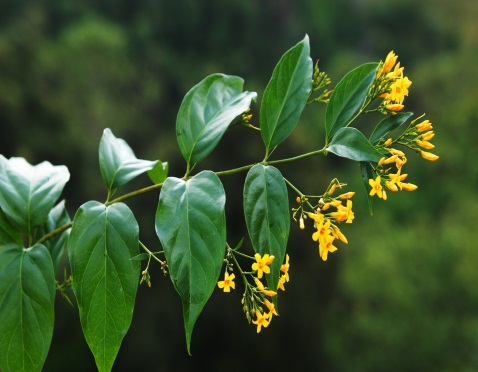The genus Gelsemium (Loganiaceae), which comprises three species in Asia (G. elegans) and North America (G. sempervirens and G. rankinii), has been recognized as a toxic plant and used as a folk medicine to treat migraines, neuralgia, sciatica, cancer, and various types of sores. A large number of indole, bisindole, and monoterpenoid alkaloids have been isolated from the Gelsemium genus. Pharmacological experiments showed that these Gelsemium alkaloids possessed cytotoxic, analgesic, anxiolytic, anti-inflammatory, and immunomodulating activities. During an earlier investigation, five monoterpenoid indole alkaloids and a new monoterpenoid alkaloid that selectively inhibited the growth of A-549 tumor cell lines were isolated from G. elegans.
Prof. XU Youkai of Xishuangbanna Tropical Botanical Garden (XTBG) has been focusing on studying the chemical components of G. elegans for many years. In a recent investigation, nine new alkaloids, including four of the koumine type (1−4), three of the humantenine type (5−7), and two of the yohimbane type (8, 9), as well as 12 known alkaloids were isolated from the leaves and perennial vine stems of G. elegans.
Compound 1 (C19H18N2O) was the first N-4-demethyl alkaloid of the koumine type, and compound 7 (C20H22N2O5) was the first nor-humantenine alkaloid, and compound 8 (C19H16N2O) and compound 9 (C21H18N2O4) were the first N-1-oxide and the first seco-E-ring alkaloids, respectively, of the yohimbane type.
Evaluations of cytotoxicity and nitric oxide production inhibition revealed that compounds 1 and 7 exhibited moderate cytotoxic activity against five human tumor cell lines with IC50 values in the range 4.6−9.3 μM.

Gelsemium elegans (Image by XU Youkai)
Key Words
Gelsemium elegans, coumpounds, leaf, vine, alkaloids
Contact
XU Youkai, Professor
Key Laboratory of Tropical Plant Resources and Sustainable Use, Xishuangbanna Tropical Botanical Garden, Chinese Academy of Sciences, Menglun 666303, Yunnan, China
Tel: 86-691-8713169
Fax: 86-691-8713061
E-mail: xyk@xtbg.ac.cn

